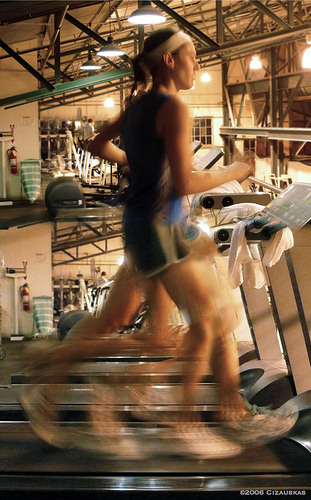By Kenneth Muir (Contributor) – Email
Print Edition: February 8, 2012
Have you ever heard someone say “you should be doing this run at 60 per cent effort” or “do these sets at 80 per cent,” without having any idea what they’re on about? Sixty per cent of what?
Typically when you hear those sorts of comments from a coach or a health instructor, they’re referring to percentages of your maximum possible effort, or more directly, your maximum possible heart rate. Trouble is, most people don’t actually know what their max heart rate is, so they end up working at a different effort level than what’s required for the workout. Making these unguided decisions can actually be extremely detrimental if you’re training for a specific goal, such as losing weight or becoming competent at the 100m dash. Training at different intensity levels trains your body to do different things. Lower intensity generally works on your body’s aerobic capacity (the ability to use oxygen effectively) and burns fat, whereas higher intensities work your body’s anaerobic capacity (the ability to exercise without sufficient oxygen) and promote muscle growth and speed. Obviously these endorse different goals. In order to stop yourself from becoming a power athlete when all you wanted to do was lose 10 pounds, you’d best figure out your max heart rate. Here’s an easy recipe to finding it:
Ingredients:
One treadmill
One stopwatch
One friend to hold the stopwatch and record heart rates (and maybe egg you on; in fact, bring some cheerleaders) (Optional)
Step 1: Become competent at checking your heart rate
Checking your heart rate is a required skill. Usually it’s easy to find the beat by pressing two fingers against either side of your trachea (for the non-science crowd: the breathing tube in your neck). Heart rate is always measured in beats per minute, so, using the stopwatch, count beats for 20 seconds, and then multiply by three. It’s not necessary to count for the whole minute, but just know that the closer to a minute that you count, the more accurate the reading. Counting for 20-30 seconds is sufficient.
If you have a heart rate monitor you can avoid all this hoo-hah, but only if you have a chest strap monitor, and then only if you know how to use it. The heart rate monitors that measure at the wrist are extremely inaccurate and should be avoided.
Step 2: Figure out the treadmill
For this test, do not change the incline percentage: it’s not necessary. Just keep it at zero. We’re only interested in the speed increments. Most treadmills calculate speed using an arbitrary whole number and one row of decimals. During this test, every time you need to change the speed, change it by half a number, such as 5.0 to 5.5.
Step 3: Start the test
After warming up, start the treadmill at a comfortable jogging speed (but only on half-number speed increments, such as 5.0, 5.5, etc.). After exactly two minutes, step to the side of the treadmill and record your heart rate. Rest only for the amount of time it takes to measure it. Next, increase the speed of the treadmill and hop back on for another two minutes. Check your heart rate again, increase the speed, and run again for another two minutes. Keep doing this until you can’t keep up with the treadmill. After you’ve fallen off the pace (hopefully not literally), immediately check your heart rate. This number is your max heart rate. It’s important to run to the absolute limit of exhaustion. It can really help to bring a friend along to time for you and to cheer you on. And know before going in: this test is brutal. The entire point is to reach your greatest limit of pain in order to acquire your max heart rate. The test is not very fun but the magic number you gain from it is well worth the effort.
With your max heart rate, you can better tailor your effort levels to match your goals. By monitoring your heart rate during and after your workout, you’ll know whether or not you’re on target by comparing your current heart rate to your max heart rate. For instance, a workout meant to be done at 60 per cent effort for someone who has a max heart rate of 200 should have a heart rate around 120 beats per minute during the workout.
It’s important to not only train hard, but to train smart. By sticking to the right effort levels by using your heart rate, you can maximize the effectiveness of your workouts to give you the results that you’re looking for.


